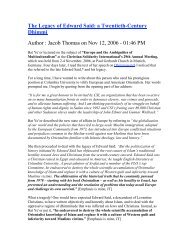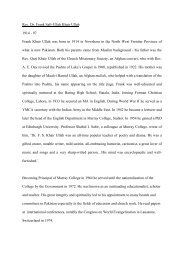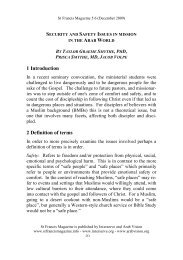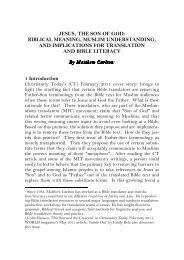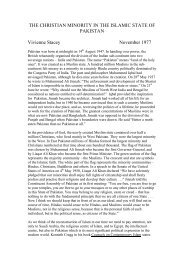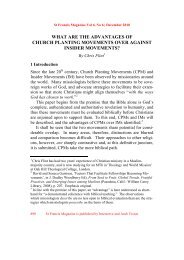- Page 1:
By Arab Vision & InterserveVol 8, N
- Page 4 and 5:
St Francis Magazine Vol 8, No
- Page 6 and 7:
St Francis Magazine Vol 8, No
- Page 8:
St Francis Magazine Vol 8, No
- Page 11 and 12:
St Francis Magazine Vol 8, No
- Page 13 and 14: St Francis Magazine Vol 8, No
- Page 15 and 16: St Francis Magazine Vol 8, No
- Page 18 and 19: 18 - เอกสารวิชา
- Page 20 and 21: St Francis Magazine Vol 8, No
- Page 22 and 23: St Francis Magazine Vol 8, No
- Page 24 and 25: St Francis Magazine Vol 8, No
- Page 26 and 27: St Francis Magazine Vol 8, No
- Page 28 and 29: St Francis Magazine Vol 8, No
- Page 30 and 31: St Francis Magazine Vol 8, No
- Page 32 and 33: St Francis Magazine Vol 8, No
- Page 34 and 35: St Francis Magazine Vol 8, No
- Page 36 and 37: St Francis Magazine Vol 8, No
- Page 38 and 39: St Francis Magazine Vol 8, No
- Page 40 and 41: St Francis Magazine Vol 8, No
- Page 42 and 43: St Francis Magazine Vol 8, No
- Page 44 and 45: St Francis Magazine Vol 8, No
- Page 46 and 47: St Francis Magazine Vol 8, No
- Page 48 and 49: St Francis Magazine Vol 8, No
- Page 50 and 51: St Francis Magazine Vol 8, No
- Page 52 and 53: St Francis Magazine Vol 8, No
- Page 54 and 55: St Francis Magazine Vol 8, No
- Page 56 and 57: St Francis Magazine Vol 8, No
- Page 58 and 59: St Francis Magazine Vol 8, No
- Page 60 and 61: St Francis Magazine Vol 8, No
- Page 62 and 63: St Francis Magazine Vol 8, No
- Page 66 and 67: St Francis Magazine Vol 8, No
- Page 68 and 69: St Francis Magazine Vol 8, No
- Page 70 and 71: St Francis Magazine Vol 8, No
- Page 72 and 73: St Francis Magazine Vol 8, No
- Page 74 and 75: St Francis Magazine Vol 8, No
- Page 76 and 77: St Francis Magazine Vol 8, No
- Page 78 and 79: St Francis Magazine Vol 8, No
- Page 80 and 81: St Francis Magazine Vol 8, No
- Page 82 and 83: St Francis Magazine Vol 8, No
- Page 84 and 85: St Francis Magazine Vol 8, No
- Page 86 and 87: St Francis Magazine Vol 8, No
- Page 88 and 89: St Francis Magazine Vol 8, No
- Page 90 and 91: St Francis Magazine Vol 8, No
- Page 92 and 93: St Francis Magazine Vol 8, No
- Page 94 and 95: St Francis Magazine Vol 8, No
- Page 96 and 97: St Francis Magazine Vol 8, No
- Page 98 and 99: St Francis Magazine Vol 8, No
- Page 100 and 101: St Francis Magazine Vol 8, No
- Page 102 and 103: St Francis Magazine Vol 8, No
- Page 105 and 106: St Francis Magazine Vol 8, No
- Page 107 and 108: St Francis Magazine Vol 8, No
- Page 109 and 110: St Francis Magazine Vol 8, No
- Page 111 and 112: St Francis Magazine Vol 8, No
- Page 113 and 114: St Francis Magazine Vol 8, No
- Page 115 and 116:
St Francis Magazine Vol 8, No
- Page 117 and 118:
St Francis Magazine Vol 8, No
- Page 119 and 120:
St Francis Magazine Vol 8, No
- Page 121 and 122:
St Francis Magazine Vol 8, No
- Page 123 and 124:
St Francis Magazine Vol 8, No
- Page 125 and 126:
St Francis Magazine Vol 8, No
- Page 127 and 128:
St Francis Magazine Vol 8, No
- Page 129 and 130:
St Francis Magazine Vol 8, No
- Page 131 and 132:
St Francis Magazine Vol 8, No
- Page 133 and 134:
St Francis Magazine Vol 8, No
- Page 135 and 136:
St Francis Magazine Vol 8, No
- Page 137 and 138:
St Francis Magazine Vol 8, No
- Page 139 and 140:
St Francis Magazine Vol 8, No
- Page 141 and 142:
St Francis Magazine Vol 8, No
- Page 143 and 144:
St Francis Magazine Vol 8, No
- Page 145 and 146:
St Francis Magazine Vol 8, No
- Page 147 and 148:
St Francis Magazine Vol 8, No
- Page 149 and 150:
St Francis Magazine Vol 8, No
- Page 151 and 152:
St Francis Magazine Vol 8, No
- Page 153 and 154:
St Francis Magazine Vol 8, No
- Page 155 and 156:
St Francis Magazine Vol 8, No
- Page 157 and 158:
St Francis Magazine Vol 8, No
- Page 159 and 160:
St Francis Magazine Vol 8, No
- Page 161 and 162:
St Francis Magazine Vol 8, No
- Page 163 and 164:
St Francis Magazine Vol 8, No
- Page 165 and 166:
St Francis Magazine Vol 8, No
- Page 167 and 168:
St Francis Magazine Vol 8, No
- Page 169 and 170:
St Francis Magazine Vol 8, No
- Page 171 and 172:
St Francis Magazine Vol 8, No
- Page 173 and 174:
St Francis Magazine Vol 8, No
- Page 175 and 176:
St Francis Magazine Vol 8, No
- Page 177 and 178:
St Francis Magazine Vol 8, No
- Page 179 and 180:
St Francis Magazine Vol 8, No
- Page 181 and 182:
St Francis Magazine Vol 8, No
- Page 183 and 184:
St Francis Magazine Vol 8, No
- Page 185 and 186:
St Francis Magazine Vol 8, No
- Page 187 and 188:
St Francis Magazine Vol 8, No
- Page 189 and 190:
St Francis Magazine Vol 8, No
- Page 191 and 192:
St Francis Magazine Vol 8, No
- Page 193 and 194:
St Francis Magazine Vol 8, No
- Page 195 and 196:
St Francis Magazine Vol 8, No
- Page 197 and 198:
St Francis Magazine Vol 8, No
- Page 199 and 200:
St Francis Magazine Vol 8, No
- Page 201 and 202:
St Francis Magazine Vol 8, No
- Page 203 and 204:
St Francis Magazine Vol 8, No
- Page 205 and 206:
St Francis Magazine Vol 8, No
- Page 207 and 208:
St Francis Magazine Vol 8, No
- Page 209 and 210:
St Francis Magazine Vol 8, No


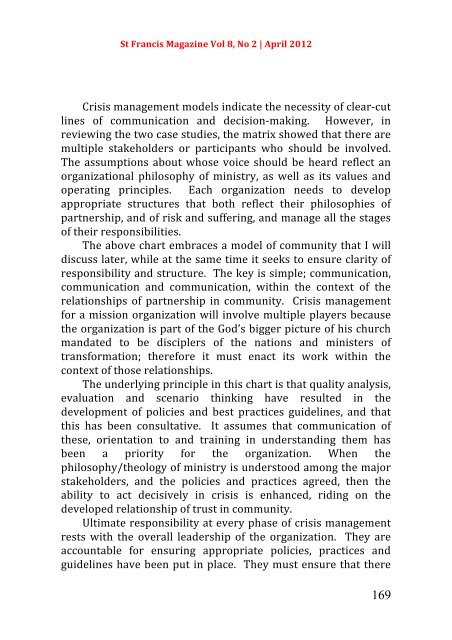

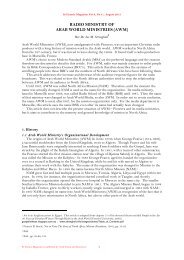
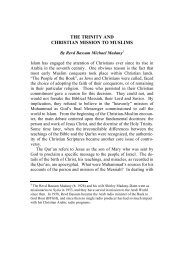
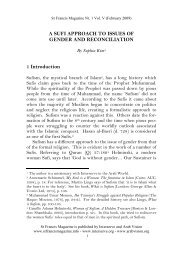
![Reflections on Surah Fatiha and the Lord's Prayer[1] - St.Francis ...](https://img.yumpu.com/49377951/1/184x260/reflections-on-surah-fatiha-and-the-lords-prayer1-stfrancis-.jpg?quality=85)
